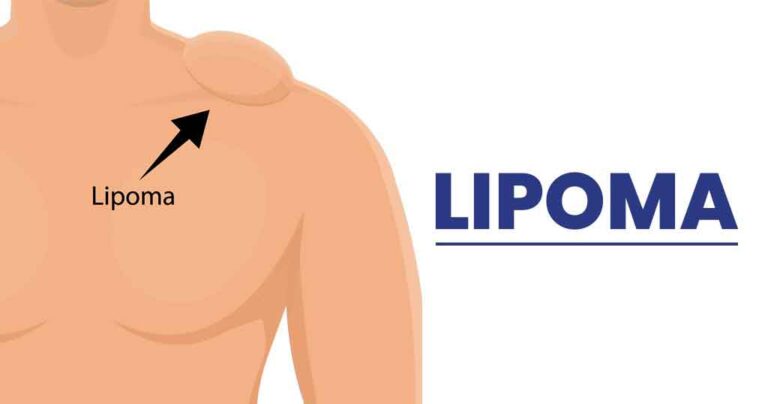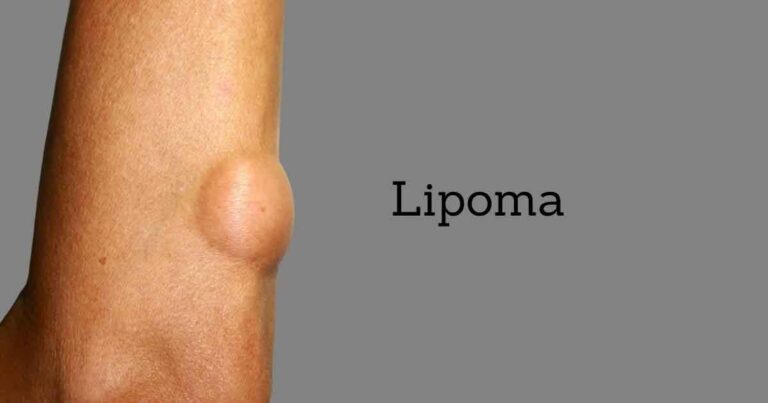WHAT IS A LIPOMA?
A lipoma is a round or oval-shaped lump of tissue that grows just underneath the skin. It is made of fat, moves easily when you touch it, and does not usually cause pain. Lipomas could appear anywhere on the body, but they are most common on the back, trunk (torso), arms, shoulders, and neck.
Lipomas are benign or mild soft tissue tumors. They grow gradually and are not cancerous. Most lipomas do not need treatment. If a lipoma is bothering you, your healthcare provider could remove it with an outpatient procedure.
HOW COMMON ARE LIPOMAS?
Lipomas are very frequent. About one of every 1,000 people has a lipoma. Lipomas appear most often between ages 40 and 60, but they could develop at any age. They could even be present at birth. Lipomas affect people of all genders, but they are slightly more frequent in women.
WHAT ARE THE SYMPTOMS OF A LIPOMA?
Lipomas are not usually painful, but they can be uncomfortable if they press against a nerve or develop near a joint. Many people who have a lipoma are not aware of any symptoms. Lipomas are generally :
- Encapsulated – They do not spread to the tissues encircling them.
- Painless – However, some lipomas cause pain and discomfort depending upon their location, size, and if blood vessels are present.
- Round or oval-shaped –The fatty lumps of rubbery tissue are generally symmetrical.
- Moveable – They sit just underneath the skin’s surface and move when you touch them.
- Smaller than 2 inches in diameter – In a few cases, lipomas can be larger than six inches wide.
WHERE DO LIPOMAS GROW?
Lipomas could develop anywhere on the body. Unusually, lipomas grow on the muscles, internal organs, or brain. The majority of people with a lipoma only have one, although more than one lipoma could grow. Most lipomas develop just underneath the skin on the :
- Arms or legs
- Back
- Neck
- Shoulders
- Trunk (chest and torso)
- Forehead
WHAT CAUSES A LIPOMA?
Healthcare providers are not sure what causes lipomas to grow. They are hereditary (passed down through families). You are more likely to develop a lipoma if somebody in your family has one.
Some conditions result in multiple lipomas forming on the body. Lipoma-causing conditions are :
Dercum’s disease – This rare disorder causes painful lipomas to grow, most frequently on the arms, legs, and trunk. It is also referred to as adiposis dolorosa or Anders’ syndrome.
Gardner syndrome – A form of a disorder known as familial adenomatous polyposis (FAP), Gardner syndrome causes lipomas and a range of health issues.
Hereditary multiple lipomatosis – Also known as familial multiple lipomatosis, this disorder is inherited (passed down through families).
Madelung’s disease – This condition happens most often in men who drink alcohol excessively. Also known as multiple symmetric lipomatosis, Madelung’s disease causes lipomas to grow around the neck and shoulders.
HOW ARE LIPOMAS DIAGNOSED?
Providers generally diagnose a lipoma during a physical examination. Your provider will touch the lipoma and ask if it is painful or tender. You may need a biopsy to confirm that the lipoma is not cancer. During this procedure, your provider removes a sample of the lipoma and sends it to a laboratory for testing.
Oftentimes, these might be mistaken for a cyst. To see a clear picture of this lump, your provider might order an imaging test such as an ultrasound, magnetic resonance imaging (MRI) scan, or computed tomography (CT) scan. These imaging studies help your provider determine whether it is a lipoma versus a cyst. It could also help identify the lipoma’s location and how deep it is if it has blood vessels and whether it is pressing against nerves or other tissues.
WHAT ARE THE TYPES OF LIPOMAS?
All lipomas are made up of fat. Some lipomas also contain blood vessels and other tissues. There are various types of lipomas, including :
- Angiolipoma – This type consists of fat and blood vessels. Angiolipomas are usually painful.
- Conventional – The most frequent type, a conventional lipoma contains white fat cells. White fat cells store energy.
- Fibrolipoma – Fat and fibrous tissue comprise this type of lipoma.
- Hibernoma – This kind of lipoma consists of brown fat. The majority of other lipomas contain white fat. Brown fat cells produce heat and help regulate body temperature.
- Myelolipoma – These lipomas contain fat and tissues that generate blood cells.
- Spindle cell – The fat cells in these lipomas are longer than they are broad.
- Pleomorphic – These lipomas contain fat cells of various sizes and shapes.
WHAT IS THE TREATMENT FOR LIPOMAS?
Most lipomas do not need treatment. If a lipoma is bothering you, your provider could remove it surgically. Lipoma removal procedures are safe and effective, and you could usually go home the same day.
As an alternative to lipoma surgery, your provider might recommend liposuction to remove the lipoma. Your provider uses a long, slim needle to remove fatty tissue from the growth.
CAN I PREVENT LIPOMAS?
Lipomas (and many of the conditions that cause lipomas) are hereditary. Since they are passed down through families, it is not possible to prevent them. You could lower your risk of developing Madelung’s disease (a condition that causes lipomas to grow) by limiting the amount of alcohol you drink.
WHAT IS THE OUTLOOK FOR PEOPLE WITH LIPOMAS?
Many people live with lipomas, and they might not even notice them. Most lipomas do not need treatment, but providers could remove them if necessary. Lipomas rarely grow back after lipoma treatment, but another one might grow in a different spot on your body.
WHEN SHOULD I SEE MY HEALTHCARE PROVIDER REGARDING LIPOMAS?
If you have skin growth, lump, or knot underneath your skin, see your provider. It is essential to get evaluated and rule out severe conditions, such as liposarcoma (a type of cancer). Symptoms of liposarcoma are the same as signs of a lipoma.
If you have a lipoma, see your provider if you notice any changes, like sudden pain. Call your provider if it is growing rapidly (over weeks), feels hard, or does not move as easily when you touch it. Your provider will check the lipoma to see if it has blood vessels, which is a sign of a rare type of painful lipoma known as an angiolipoma.
Note – Millions of people are living with lipomas. They could be annoying and unsightly, but they do not usually cause problems. Most lipomas do not need treatment. But if a lipoma causes pain or you are concerned about its size or location, see your provider. Usually, providers could remove lipomas during an outpatient procedure, which means you will probably go home the same day. Lipomas unusually grow back after they have been removed.
If you or anyone you know is suffering from a lipoma, our expert providers at Specialty Care Clinics will take care of your health and help you recover.
Call 469-545-9983 to book a telehealth appointment for an at-home check-up.




